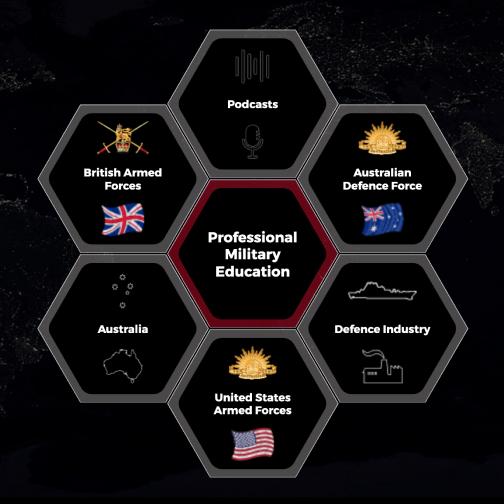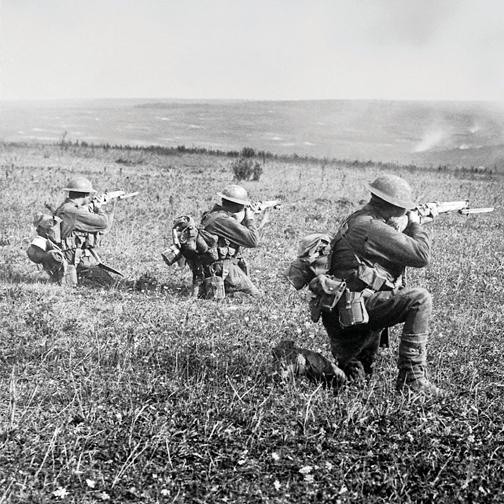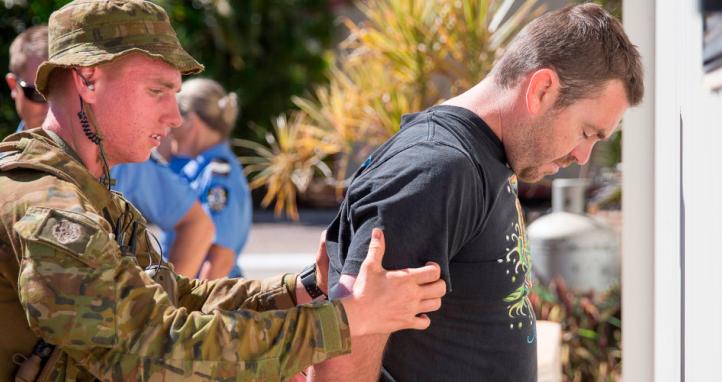As I stand before you, I follow and honour a distinguished cohort of leaders who, previously, delivered the Major General Sir James Harrison Memorial Lecture. These leaders include Lt Gen Sir Thomas Daly KBE CB DSO, who presented the inaugural Harrison Memorial Lecture in November 1982 through to: Sir Roden Cutler VC AK KCMG CBE, General Sir Arthur MacDonald KBE CB, Admiral Sir Anthony Synnot KBE AO, General Sir Francis Hassett AC KBE CB DSO LVO, and Sir Edward ‘Weary’ Dunlop AC CMG OBE.
The purpose of the Harrison Lecture is to ‘increase the efficiency of the Army by educational means, and more specifically for the purpose of fostering among officer cadets at military institutions a deeper understanding of command and leadership qualities at higher levels of the Defence Force.’[1]
I am humbled by the invitation, and I aim to provide you, as those before me have certainly provided, some practical guidelines for your next leadership journey.
I deliberately frame this conversation with you as practical guidelines for your next leadership journey. You are already proven leaders. Your selection to the Royal Military College, Duntroon, a paramount Australian and international school enabling creative, critical, and complex thinking, is testament to your leadership and your leadership potential.
The leadership that you possess and the potential you demonstrate are built on firm foundations of your own schooling, sport, hobbies, parents, family, mentors, friends, and community. Firm foundations support strong character. And your character has been continuously tested by the Royal Military College. Through this testing, you have navigated through learning, success, probable setbacks, and possible failures – leading to personal, professional and cultural growth, adaptation, and excellence.
And here you are today. Less than one week from your Graduation and ready to share your talents with the world.
First, let us consider character. Next, let us consider five leadership principles.
On character, members of the Australian Army (and our domain partners and allies) are widely recognised and respected in our community and globally for moral excellence, selfless courage, committed principles, and sound judgment. Unwavering character enables our Soldiers and leaders to pursue honourable actions.[2]
Character is developed every day in barracks, on duty, on exercise, on operations, and on leave wherever we are around our family, our friends, our community, our nation, our region, and globally.
We are not born with character. Character is developed by the experiences and the decisions that guide our lives.
Neither can we borrow the character or reputation of another. Each soldier and each leader creates, develops, and nurtures their own character. That is why each of us must learn to make good moral decisions in our lives.
When the right course of action is unclear, only the habit of doing the right thing, as practiced every day in all areas of our lives, can be counted upon. Well-developed character is our shield against hardship, fear, and despair.
Character is readiness. The Australian Army is a ready force. Not a force, when called, that struggles to get ready. Our challenge is to serve as an army of soldiers and leaders who consistently represent the highest moral character both in and out of uniform.
Character creates a foundation upon which successful armies – from four-person fire teams to multi-domain, multi-agency, and multi-national formations – are built. Upon this foundation, our Defence Values – service, courage, respect, integrity and excellence – are always evident. These values, led by our soldiers and leaders, ‘inspire others, ignite their hearts, and illuminate the way’ for mission success.[3]
Second, let us consider five leadership principles: (1) work with others to achieve more; (2) move towards the friction; (3) you can achieve anything you want in life, if you don’t seek the credit; (4) calm is contagious; (5) always have the strategic view.
These five leadership principles are born of service. Few are original. Many are borrowed. Some are repurposed. All are adapted to my own character, experience, and bias to learn. These principles are not fixed. I anticipate that additional principles may emerge, as I continue to grow and learn as a leader.
Importantly, these five leadership principles are a safe place, including life-long human mistakes and vulnerabilities, to begin framing, analysing and solving complex, adaptive, and wicked problems. You may think of these five leadership principles as your own, back-pocket, Decision-Making and Planning Process (DMPP).
As articulated in the DMPP, ‘commanders guide the planning process through their understanding, visualisation, description and leadership and then [through their] continuous response to assessment.’ Then to assist the commander, ‘staff and subordinates provide information, advice and detail to enable the execution of decisions.’[4]
The DMPP offers excellent guidance. But, this guidance, like all doctrine and theory, needs a spark of humanity. People matter most, and people differ in their culture, skills, productivity, resilience, fortitude, resourcefulness, and personality.[5] As John Keegan notes:
There was nothing about rum in Clausewitz, or about commanding officers having nervous breakdowns, or about one sort of warrior being better than another, or about officers bullying their subordinates. The warrior in Clausewitz was a sort of cipher – a being subject to fear and fatigue and capable of bravery – but faceless, unindividualistic and asocial.[6]
Employing the five leadership principles, as a place, with human mistakes and vulnerabilities, I will now describe how leadership enabled a solution to Crowdstrike in July 2024.
CrowdStrike 19 July 2024
CrowdStrike is an American cybersecurity company known for its endpoint security, threat intelligence, and cyberattack response services. They offer a suite of products, including Falcon, an endpoint detection and response (EDR) agent that works at the operating system entry level to detect and prevent threats.
CrowdStrike also provides managed detection and response (MDR) services and cloud security solutions. As of April 2025, CrowdStrike has a market capitalisation of $93.67 billion USD.
CrowdStrike outage explained: What caused it and what’s next?
A CrowdStrike botched software update caused a massive information technology outage, showing the infamous blue screen of death (BSOD). Importantly, the BSOD rendered each system inoperable using the normal boot process.
Microsoft estimates that approximately 8.5 million Windows devices were directly affected by the CrowdStrike logic error. That is less than one per cent of Microsoft's global Windows install base. The outage was not a Microsoft Windows error, but rather a logic error in CrowdStrike Falcon.
Insurers estimate the outage cost U.S. Fortune 500 companies $5.4 billion.
CrowdStrike identified and deployed a fix for the issue in 79 minutes. However, recovery processes for businesses and government agencies, including emergency services, are labour-intensive, complex, time-consuming, and were conducted under pressure from threat actors (e.g. phishing emails, fake phone calls, selling recovery scripts, and posing as independent researchers). In some cases, recovery required physical access to each machine, especially with encrypted drives, adding further time and effort to the process.
By 29 July 2024, CrowdStrike reported that approximately 99% of affected Windows sensors were back online.
Employing the five leadership principles: CrowdStrike 19 July 2024.
At the time of CrowdStrike, I was serving in the National Emergency Management Agency, Emergency Management and Response Group.
1) Work with others to achieve more: the solution to Crowdstrike required intimate and immediate coordination, cooperation, and collaboration between the Crowdstrike business, National Emergency Management Agency, Department of Home Affairs, and the Australian Signals Directorate. This was achieved through teamwork: working with others to achieve more.
Teamwork is exemplified, in Australia, by the National Coordination Mechanism, or NCM, enabling mutual trust, shared understanding and disciplined initiative between and among key leaders, protectors, and enablers of Australian society.
Since 2020, 674 NCMs have been conducted. The NCM supports rapid problem definition and coordinated action. The NCM is flexible, scalable, and applicable to all hazards according to the Australian Government Crisis Management Framework, 2024.
The NCM works with others to achieve more as the peak senior officials’ crisis coordination system providing a national picture of crisis to governments and key stakeholders. The NCM provides the convening mechanism to bring together Australian Government, state, and territory government and non-government representatives immediately before, during, and after a crisis.
For CrowdStrike, the NCM considered:
- 000 / Emergency Alert systems in States / Territories;
- Water;
- Food and groceries;
- Health, aged care and disability services;
- Public transport;
- Airlines and airports;
- Local governments;
- Small businesses;
- Banking and financial services;
- Energy and fuel supply;
- Media and broadcasting;
- Payment services;
- Ports, road, rail, freight; and,
- Schools and universities.
Importantly, through the eight Crowdstrike NCMs, held between 19 July and 22 July 2024, working with others to achieve more allowed Crowdstrike NCM leaders to demonstrate their care and support for all members of the Australian community. This care and support caused ripples of influence, enabling all Australians to optimally respond and recover from Crowdstrike and, in turn, to continue sharing their talents with the world.
2) Move towards the friction. The first NCM was held within two hours and four minutes of our notification of the Crowdstrike incident. The first NCM defined and framed the Crowdstrike problem. The next seven NCMs then converted the Crowdstrike definition and framing into nationally coordinated actions.
Following the first NCM, members of the NCM immediately focused on their agreed actions. I consulted with others and then spent that Friday evening preparing for how to optimally co-lead the next and following NCMs based on what our nation needed.
The key preparation document was the NCM annotated agenda. Through this document we could work with others to: collaboratively share information, propose solutions, and agree on actions. The annotated agenda established guidelines for the CrowdStrike NCM, including:
- Shared understanding of the situation.
- Purpose.
- Actions, conditions, and solutions offered and sought from various stakeholders.
- Decisions, guidance, timings, and resources requested or required.
- Key relationships established or needed.
- Risk, including who holds the risk and for how long risk is held.
- Transition and continuity beyond the current crisis.
Once the NCM annotated agenda was created, the CrowdStrike NCM gained and maintained a rhythm. Simultaneously, stakeholders gained a personal and a shared understanding of the situation. Importantly, the CrowdStrike business identified and deployed a fix for the issue.
3) You can achieve anything you want in life, if you don’t seek the credit. Under the Australian Government Crisis Management Framework, 2024, the Department of Home Affairs was the Coordinating Agency for the CrowdStrike incident.
This meant that the Department of Home Affairs was the lead agency, with the National Emergency Management Agency and others in support. In particular, the Department of Home Affairs was the lead agency in public messaging and crisis communications for the CrowdStrike incident.
4) Calm is contagious. As noted earlier, the first NCM was held within two hours and four minutes of our notification of the Crowdstrike incident. With 674 NCMs of experience, many Australian departments and agencies at Federal, State, and Territory levels, and businesses, know the NCM process and are comfortable with NCM requirements.
This broad NCM experience and knowledge provides comfort to stakeholders. Which means, NCM participants are ready to work with others to solve the problem at hand. Stakeholders understand that Australia is a big country with a relatively small community. In many senses, we know ourselves, we know each other, and we know our communities. The NCM amplifies this self, interpersonal, and community knowledge – enabling our unification into a common purpose.
Combined, during the Crowdstrike NCM experience, knowledge, and common purpose led to calm. And a calming environment led to more calm, where calm is contagious.
5) Always have the strategic view. In many respects, the CrowdStrike outage was a real manifestation of fears that computing users had at the end of the last century with the Y2K bug.
With Y2K, the fear was that a bug in software systems would trigger widespread technology failures. While the CrowdStrike incident was not Y2K, it was a software issue that did, in fact, trigger massive disruption on a scale that we have not previously experienced.
So, CrowdStrike was a rehearsal. As you appreciate from your training here at Duntroon, well planned rehearsals reveal and share our conceptual and detailed understanding of an operation or activity.
Rehearsals require active participation, not simple observation. Rehearsals are habits of action. Rehearsals are built on a foundation of soldier and leader practice and unit standard operating procedures.
Before executing an operation or activity, rehearsals allow leaders to:
- orient themselves and their teams to the environment.
- relay their leader’s intent.
- practice key aspects of planned operations.
Well-planned rehearsals exercise the plan while including operational uncertainty and ambiguity, which empowers people to act with creativity and adaptability. Importantly, we need to teach leaders how we want rehearsals conducted before we require and employ leaders in the planning process.[7]
I am honoured to share some thoughts with you today on character and five leadership principles. Thank you for your attention today. Congratulations on your Graduation. Blessings to all of you in conquering – with grit, determination, and grace – all future challenges.
End Notes:
[1] Loyalty and Service: The Officer Cadet School Portsea, Part 4 The Corps and Its Graduates, Chapter 11, Esprit de Corps: The Corps https://historia.net.au/loyalty-and-service_portsea/ls-p4_corps/ls-c11_esprit.html [accessed 16 April 2025]
[2] General Charles Krulak, All Marine: Character, Headquarters United States Marine Corps, Washington, D.C. 09 July 1996
[3] LtGen John A. Toolan Jr., Professional Development, Marine Corps Association Professional Dinner at Kaneohe Marine Base, Hawaii, 2015 [quoted in: Marine Corps Gazette – Professional Journal of the US Marine Corps, Quantico, Virginia, Vol 107, No. 11, November 2023, p. 74]
[4][4] Australian Defence Force, Integration – 5 Decision-Making and Planning Processes, Edition 1, Department of Defence, Canberra, 21 October 2024, p. 34
[5] Colin S. Gray, Modern Strategy, Oxford University Press, 1999, Oxford, United Kingdom, p. 26
[6] John Keegan, Towards a Theory of Combat Motivation, in Paul Addison and Angus Calder (eds.), Time to Kill: The Soldier’s Experience of War in the West, London, 1997, pp. 4-5
[7] CPT Luke C. Bowers, The Rehearsal Is the Thing!, Armor, Mounted Maneuver Journal, Professional Bulletin of the Armor Branch, Headquarters, Department of the Army, Fort Benning, Georgia, USA, Fall 2017, Vol. CXXIX, No. 4, pp. 42-45
https://www.benning.army.mil/armor/earmor/content/issues/2017/Fall/ARMOR_Fall_2017_edition.pdf [accessed 16 April 2025]










I especially appreciated your wisdom also to "move towards the friction" and aiming high but not seeking credit. Your insights about calmness being contagious is critical in complex, changing, contested and anxious situations.